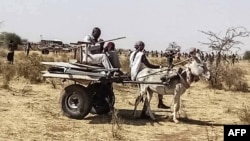It started as a land dispute between two individuals, one from the Rizeigat and the other from the Gimir, before escalating into broader violence involving other members of the two tribes.
The latest fighting between the Arab Rizeigat and non-Arab Gimir tribes broke out on June 6 in Kolbus district, about 160 kilometres (100 miles) north of the West Darfur state capital, El Geneina.
Between June 6 and June 11, "over 125 people were killed, and many others were injured due to the conflict," said a report from the UN Office for the Coordination of Humanitarian Affairs.
The UN said the Gimir community lost 101 dead, and the Rizeigat 25.
Gimir tribal leader Ibrahim Hashem said the situation "remained tense" in all the villages in and around Kolbus.
He said the government had deployed units largely drawn from the paramilitary Rapid Support Forces (RSF) around the Gimir villages.
The UN said it estimates around 50,000 people have been displaced by the latest fighting which has spilt over into neighbouring districts of West Darfur.
Some 25 Gimir villages "were reportedly attacked, looted and burnt," it said.
The RSF is largely made up of Arabs who formerly served in the infamous Janjaweed militia recruited by the now ousted regime of president Omar al-Bashir to suppress an armed rebellion launched among Darfur's non-Arab minorities in 2003.
The scorched earth policy adopted by the Janjaweed against minority villages left 300,000 people dead and 2.5 million displaced, according to UN figures.





![Sudan Opposition Group Holds 'Unofficial' Meeting With Military [3:50]](https://gdb.voanews.com/294e8ea6-3adb-4b5e-a31c-8dd5e7835754_w33_r1.jpg)



